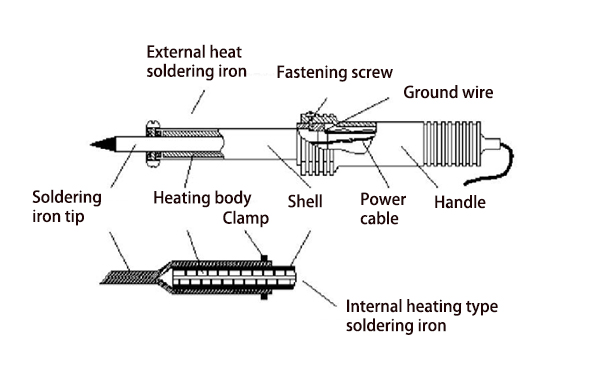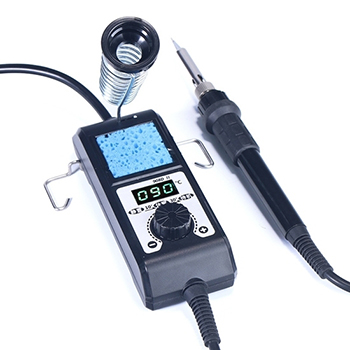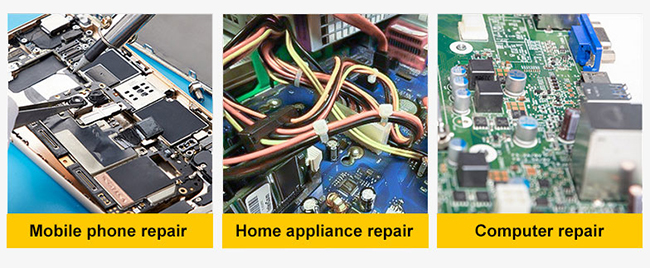How do I Choose Soldering Iron?
The electric soldering iron is a tool used to solder components or wires and can be used for mobile phone repairs, electronic production, etc. The use of electric soldering iron requires strong technical skills, and professional selection can make it more convenient for us to use the soldering iron. Next, ATO will introduce to you the selection guidance for electric soldering irons.
Type of soldering iron
There are two types of electric soldering irons: internal heating type and external heating type. Internal heating electric soldering irons mainly include 20W, 30W, 35W, 45W, 50W, and 75W. In addition to all the wattages of the internal heating type soldering iron, there are 100W, 150W, 300W, and other types.
- When using circuit boards for soldering transistors, integrated circuits, and other devices, it is better to use an internal heating type 20W electric soldering iron.
- If you want to weld metal materials, you should choose an external heating type electric soldering iron above 100W.
- When it is necessary to solder integrated circuits, transistors, and components that are vulnerable to heat, consider using a 20W internal heating or 25W external heating electric soldering iron.
- When welding thicker wires or coaxial cables, consider using a 50W internal heating type or a 45W ~ 75W external heating type electric soldering iron.
- If conditions permit, it can be equipped with 20W internal heat type, 35W internal heat or external heat type, and 150W external heat type electric soldering iron, so that it can basically meet various welding needs.

Choosing method
Choice of internal heating and external heating:
Under the same wattage conditions, the temperature of the internal heat soldering iron is higher than that of the external heat soldering iron.
When low-temperature soldering is required, a voltage regulator should be used to control the temperature of the soldering iron. The temperature of the electric soldering iron is closely related to the power supply voltage. In actual use, the temperature of the electric soldering iron is often reduced by lowering the power supply voltage. Adjusting the extension length of the soldering iron tip can control the temperature.
There are mainly the following methods to stabilize the temperature of the electric soldering iron:
- Install a stabilized power supply to prevent changes in the power supply network.
- The soldering iron tip maintains a certain volume, length, and shape.
- A constant temperature electric soldering iron is used to keep the indoor temperature constant, avoiding natural wind or electric fan wind, etc.
- The shape of the soldering iron tip should adapt to the surface requirements of the weldment and the assembly density of the product.
To put it simply, the power and type of the electric soldering iron should be reasonably selected according to the welding object. If the workpiece to be welded is larger, the power of the electric soldering iron used should also be larger. If the power is low, the soldering temperature is too low, the solder melts slowly, the flux is not easy to volatilize, and the solder joints are not smooth and firm. This situation will inevitably lead to unqualified appearance quality and welding strength, and even lead to the inability of the solder to melt and the result that the welding cannot be performed.
However, the power of the portable soldering iron should not be too large. If it is too large, too much heat will be transferred to the workpiece to be welded, and the solder joints of the components will be overheated, which may cause damage to the components. The copper foil of the printed circuit board is peeled off, and the solder flow on the soldering surface is too fast and uncontrollable.
The selection of electric soldering iron generally follows the following principles:
The shape of the soldering iron tip should adapt to the surface requirements of the weldment and the assembly density of the product.
The temperature of the tip of the soldering iron tip should be compatible with the melting point of the solder, which is generally 30~80°C higher than the melting point of the solder. (Excluding the temperature drop when the tip of the soldering iron touches the solder joint)
The heat capacity of the soldering iron should be appropriate. The temperature recovery time of the soldering iron tip should be adapted to the requirements of the surface of the weldment. The temperature recovery time refers to the time required for the tip temperature of the soldering iron tip to return to the maximum temperature after the temperature is reduced due to heat loss during the soldering cycle. It is related to the power of the electric soldering iron, heat capacity, and the shape and length of the soldering iron tip.
Factors Affecting Welding
Solder
- Solder is a fusible metal that enables component leads to be joined to the connection points on a printed circuit board.
- Tin is a soft, malleable silver-white metal with a melting point of 232°C. It has stable chemical properties at room temperature, is not easily oxidized, does not lose its metallic luster, and has strong resistance to atmospheric corrosion.
- Lead is a soft light blue-white metal with a melting point of 327°C. High-purity lead has strong atmospheric corrosion resistance and good chemical stability, but it is harmful to the human body.
Adding a certain proportion of lead and a small amount of other metals to tin can make solder iron with a low melting point, good fluidity, and strong adhesion to components and wires, and is generally called solder. Solder can be divided into 15 types according to the amount of tin content, and can be divided into three grades: S, A, and B according to the chemical composition of tin content and impurities.
Flux
Flux can generally be divided into inorganic flux, organic flux, and resin flux. The flux can dissolve and remove oxides on the metal surface, and surround the metal surface to insulate it from the air during soldering heating, preventing the metal from oxidizing during heating. It can also reduce the surface tension of solder and facilitate the wetting of solder.
Solder resist
Limit the solder to only solder on the required solder points, cover the board surface of the printed circuit board that does not need to be soldered, and protect the panel so that it receives less thermal shock during soldering and is not prone to blistering. At the same time, it also prevents bridging, tipping, short circuit, false welding, and so on. When using flux, it must be applied in an appropriate amount according to the area size and surface state of the workpiece to be welded. If the amount is too small, the welding quality will be affected. If the amount is too much, the flux residue will corrode the components or deteriorate the insulation performance of the circuit board.

